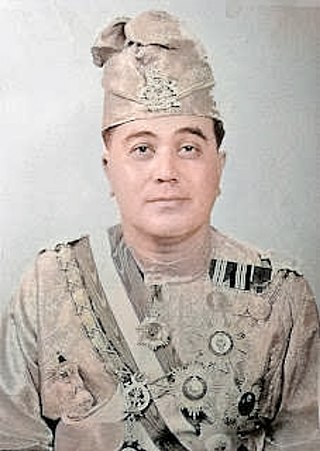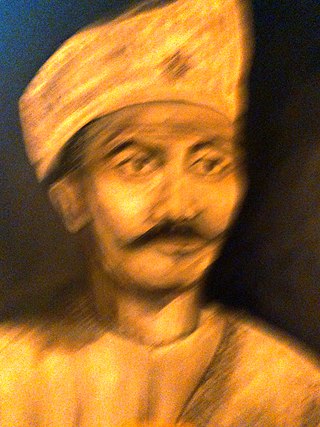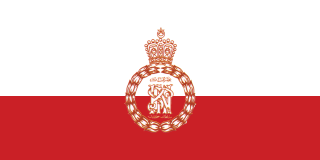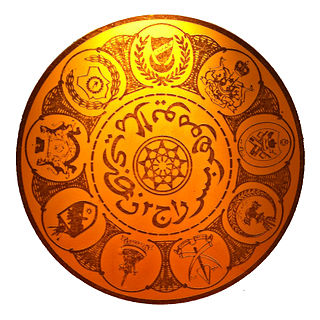The Malay language has a complex system of styles, titles and honorifics which are used extensively in Brunei Darussalam, Malaysia and Singapore.

The Queen of Malaysia, officially Raja Permaisuri Agong is the consort of the Yang di-Pertuan Agong, the elected, constitutional federal monarch of Malaysia.

Al-Mu’tassimu Billahi Muhibbuddin Sultan Abdul Halim Mu'adzam Shah ibni Almarhum Sultan Badlishah was the 28th Sultan of Kedah from 1958 until his death in 2017, and served twice as the Yang di-Pertuan Agong from 1970 to 1975 and from 2011 to 2016. He was the first and only ruler to reign as Yang di-Pertuan Agong twice, as well as the oldest elected to the office. Prior to his death, he was the second longest-reigning living monarch in the world after Queen Elizabeth II of the United Kingdom.

Sultan Sir Ismail Nasiruddin Shah ibni Almarhum Sultan Haji Zainal Abidin III Mu’azzam Shah was the Sultan of Terengganu from 1945 until his death in 1979, and the fourth Yang di-Pertuan Agong,, from 1965 to 1970.

Sultan Yahya Petra ibni Almarhum Sultan Ibrahim was Sultan of Kelantan from 1960, and the sixth Yang di-Pertuan Agong, the constitutional monarch of Malaysia, from 1975, until his death in 1979.

Tuanku Muhriz ibni Almarhum Tuanku Munawir is the eleventh Yang di-Pertuan Besar of Negeri Sembilan, Malaysia. He is the only son out of six siblings of royal spouse, the ninth Yang di-Pertuan Besar of Negeri Sembilan Tuanku Munawir and his spouse, Tunku Ampuan Durah.

Al-Wathiqu Billah Sultan Mizan Zainal Abidin ibni Almarhum Sultan Mahmud Al-Muktafi Billah Shah is the Sultan of Terengganu, reigning since 1998. He previously reigned as the thirteenth King of Malaysia, from 2006 to 2011.

Raja Mahmud ibni Almarhum Sultan Abdul Jalil, known as Raja Melewar, was the first Yamtuan Besar of Negeri Sembilan, Malaysia. He was a prince from the Pagaruyung Kingdom in Sumatra, now situated within Indonesia.

Sultan of Selangor is the title of the constitutional ruler of Selangor, Malaysia who is the head of state and head of the Islamic religion in Selangor. The current monarch, Sultan Sharafuddin Idris Shah ascended the throne on the death of his father, on 22 November 2001.

The Yamtuan Besar, also known officially as Yang di-Pertuan Besar and unofficially as Grand Ruler, is the royal title of the ruler of the Malaysian state of Negeri Sembilan. The Grand Ruler of Negeri Sembilan is elected by a council of ruling chiefs in the state, or the Undangs. This royal practice has been followed since 1773. The Yamtuan Besar is elected from among the four leading princes of Negeri Sembilan ; the Undangs themselves cannot stand for election and their choice of a ruler is limited to a male Muslim who is Malay and also a "lawfully begotten descendant of Raja Radin ibni Raja Lenggang", the 4th Yamtuan.

Tuanku Sir Muhammad Shah ibni Almarhum Tuanku Antah was the seventh Yamtuan Besar of Seri Menanti, and ruled from 1888 to 1933. During his reign, Negeri Sembilan came under British protection in 1889 and became a Federated Malay State in 1895.

The Sultan of Kelantan is the constitutional head of Kelantan state in Malaysia. The executive power of the state is vested in him as the monarch of the state. The current sultan, Muhammad V, is the 29th Sultan of Kelantan. He is the Head of Islam in the state and the source of all titles, honours and dignities of its people. He was the 15th Yang di-Pertuan Agong or the monarch and head of state of Malaysia from 13 December 2016 to his abdication on 6 January 2019, after his election on 14 October 2016 at the 243rd (special) Conference of Rulers.
Tunku Besar Burhanuddin ibni Almarhum Yamtuan Antah was a member of the Negeri Sembilan royal family and once served as regent of Negeri Sembilan. His father was Yamtuan Antah ibni Yamtuan RadIn, who served as the 6th Yamtuan Besar from 1869 to 1888. Tunku Burhanuddin's elder brother, Tuanku Muhammad became the 7th Yamtuan Besar and the first to use the title Yang di-Pertuan Besar upon Yamtuan Antah's death.

The monarchies of Malaysia exist in each of the nine Malay states under the constitutional monarchy system as practised in Malaysia. The political system of Malaysia is based on the Westminster parliamentary system in combination with features of a federation.
The Most Illustrious Royal Family Order of Kedah is the highest dynastic order of the House of Sri Mahawangsa and the second highest chivalric order of the state of Kedah ranking immediately after the State of Kedah Star of Valour. The order was constituted by Sultan Abdul Halim of Kedah on 21 February 1964.

Riau-Lingga Sultanate, also known as the Lingga-Riau Sultanate, Riau Sultanate or Lingga Sultanate was a Malay sultanate that existed from 1824 to 1911, before being dissolved following Dutch intervention.

Tuanku Munawir ibni Almarhum Tuanku Abdul Rahman was the ninth Yang Di-Pertuan Besar of the Malaysian State of Negeri Sembilan. He was the eldest son of the first Yang Di-Pertuan Agong, Tuanku Abdul Rahman with his second consort Tunku Maharun.

The Indonesian Malaysians are Malaysian citizens of Indonesian ancestry. Today, there are many Malaysian Malays who have lineage from the Indonesian archipelago and have played an important role in the history and contributed to the development of Malaysia, they have been assimilated with other Malay communities and are grouped as part of the foreign Malays or anak dagang in terms of race. The Malaysian census does not categorize ethnic groups from the Indonesian archipelago as a separate ethnic group, but rather as Malay or Bumiputera.
Paduka Sri Sultan Sulaiman Badr ul-‘Alam Shah Khalifat ul-Muminim ibni Almarhum Sultan ‘Abdu’l Jalil Ri’ayat Shah, or simply Sulaiman Badrul Alam Shah of Johor and known as Raja Sulaiman before his ascension to the throne was the 14th Sultan and Yang di-Pertuan Besar of Johor and Pahang and their dependencies who reigned from 1722 to 1760. He succeeded on the defeat of the claimant to Johor throne, Raja Kecil who reigned in Johor from 1718 to 1722.

The Royal Family Order of the Crown of Brunei is an order of Brunei. It was established on 15 August 1982 by Sultan Hassanal Bolkiah. The order carries the post-nominal letters "DKMB".















